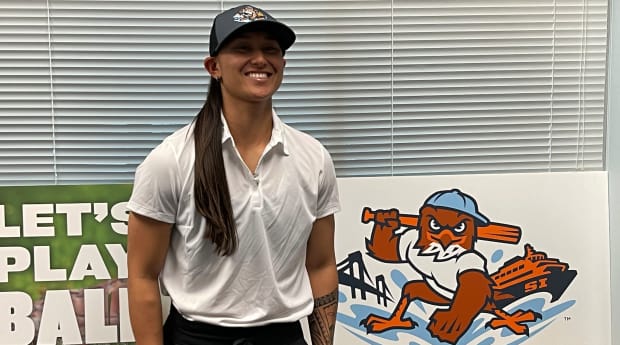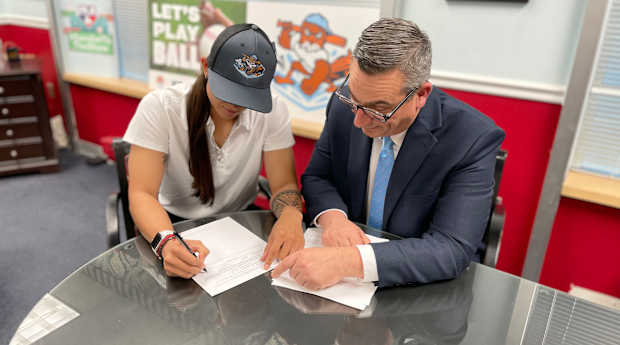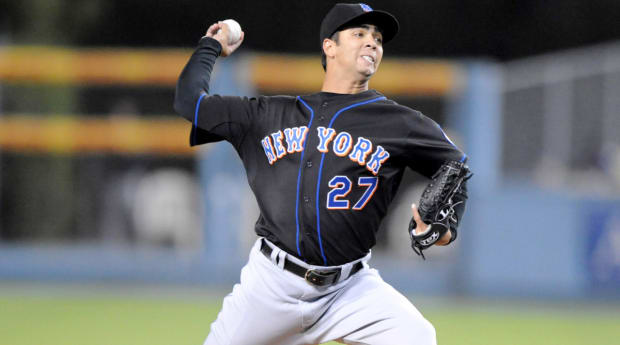The thing to understand about 23-year-old Kelsie Whitmore’s path to signing a contract with the Atlantic League’s Staten Island FerryHawks—the highest level attained by a woman in professional baseball in more than a generation—is that there is no path. Not for women to play baseball.

Joe Langan/Staten Island FerryHawks
From a young age, girls are asked, then gently nudged, then usually forced to switch from baseball to softball. Only this year did a women’s collegiate baseball championship, created by Justine Siegal’s Baseball for All, even exist, and the sport at the college level is in its infancy. A game that requires reps to succeed has long denied them to women, a self-fulfilling prophecy keeping them from advancing on the field.
And yet: Siegal said she knew Whitmore would do important things in baseball the first time she saw Whitmore pitch back in 2014, as a 15-year-old at a Baseball for All tournament.
“I've always known that Kelsie would be the one,” Siegal says. “Not only was she better than the others, but when you get to know Kelsie, you realize what a quality person she is. I just think she's the full package. Her work ethic is beyond. And I'm just so impressed with her mental toughness.”
It is a package required to do both what she’s already accomplished in baseball, and what will be asked of her now: to prove that she is capable of getting hitters out in an elite independent league, one that has sent 83 players on to affiliated ball since just the start of the 2021 season.
That’s the goal Whitmore has, too, and for a player long searching for the opportunity to prove herself, signing with the FerryHawks doesn’t feel like a burden. It's a relief, the chance to join her fellow ballplayers at the starting line.
“It feels like pressure, a lot of pressure, but you just change your perspective to embrace that pressure,” says Whitmore, standing in the office of FerryHawks general manager Gary Perone, the man who signed her Thursday. “And then using that to compete.
“Know that there’s going to be failures that come with it, and understand that's part of it. I’m going to make mistakes; I'm going to fail. And that’s all part of it. And my biggest goal was to come here to develop, and gain knowledge to be the best version of myself.”
Whitmore is the kind of person whose drive and talent are so self-evident, those who come into her orbit cannot wait to help her succeed. Siegal has spent years trying to find any and all openings for Whitmore to ply her trade, getting her a gig pitching for the independent Portland Pickles last summer on their trip to Mexico. As usual, Whitmore excelled, throwing five shutout innings in her start and blasting a double in her time at the plate. At age 17, she played for the independent Sonoma Stompers, too. She is always wary, however, of getting opportunities born of publicity and not her ability to compete on the field.
So when Parone engaged her about playing, both sides quickly understood what Whitmore is about: doing the work and winning.
She’s long been a dual threat for USA Baseball’s women’s team, dating back to her gold medal at the Pan Am Games in 2015, and she pitched to a 1.35 ERA over 26 ⅔ innings with Team USA from ’14 to ’19. The Atlantic League is also adopting the Shohei Ohtani Rule, allowing the starting pitcher to DH, so Whitmore, who also plays the outfield, relishes the chance to both hit and potentially stay in the game as DH once her pitching duties are through. She hit .348 for Team USA in the ’19 Pan-Am games. The FerryHawks have noticed, too—they’re thinking of her as a two-way player.
What everyone who knows her agrees will be a life in baseball started at age 6, when she played catch with her father, Scott, a phys ed teacher. Scott took her to the local little league and gave her the choice: baseball or softball? Whitmore didn’t hesitate.
“She knew at that age she just wanted to play that sport,” Scott says. “She wanted to throw overhand. She wanted to steal bases. She wanted to do what baseball players do. So I didn’t set the direction. She did.”
Even so, she deviated to softball in college at Cal State-Fullerton, simply because there weren’t any college baseball teams for women, let alone scholarships. She excelled at her adopted sport, winning 2021 Field Player of the Year in the Big West Conference with a .395/.507/.824 slash line.
But she never stopped working at her baseball craft. For years, she’s trained with former major leaguer Joe Beimel at Beimel Elite Athletics, looking to maximize her ability to command her five-pitch arsenal and turn herself into the best ballplayer she can be.
But for what, exactly? Even she and her longtime friend, fellow player Luisa Gauci, didn’t know as they worked to train together at Beimel through the long months of 2020. For Gauci, the dream was to play Division I baseball, that goal as detached from the opportunities women were receiving as Whitmore’s affiliated baseball aspirations. They talked often over those months, the two women in the program, knowing little about their future beyond their daily desire to improve.

Joe Langan/Staten Island FerryHawks
And that’s the essential point of Whitmore in the Atlantic League, as Gauci sees it. They’d both happily play in a professional women’s league, once there is one. It’s simply about making sure women who want to play baseball can do so for as long as they want. She knows, even as her friend gets this chance, if Whitmore fails, it will be used as a referendum in many circles to deny Gauci and others similar opportunities. If Whitmore succeeds, Gauci knows she’ll be the point of reference.
“I'm an infielder,” Gauci says incredulously. “Kelsie is probably five or six inches taller than me, a little older than me. She's a ton more experienced than me. And we play different positions. Completely different. So why would you compare? Why are you comparing a pitcher to an infielder?”
Even so, Gauci is rooting for her friend, for what it will mean for her, and for women in the game to have a seat at the table. It’s been a long time coming. Whitmore overlapped with Ila Borders at USA Baseball late in Borders’s career, an attempted comeback more than two decades after she pitched in independent ball from 1997 to 2000, notching a pair of victories over four seasons and 101 ⅓ innings. As with Whitmore, Borders was a control pitcher—so regular reps were key, and, over that period, she didn’t get them.
It’s clear to all involved that there is a pathway to success for Whitmore. Gauci, who now works full-time at Driveline with scores of Atlantic League players, said she’s seen those hitters absolutely crush pitching-machine fastballs thrown at Whitmore’s velocity—when they know what’s coming. But change up the pitch sequencing, and even at Whitmore’s game speeds, it is very possible to get out the best of these hitters.
Proving that, though, requires the chance. She’d received offers from several other leagues to play in 2022, but that familiar worry of exactly why they wanted her kept creeping into her consciousness. And Whitmore, with each day she didn’t have a team, wasn’t putting up numbers allowing talent evaluators to get a sense of her skills. Velocity is the best way for lesser-known pitchers to draw the attention of scouts.
It’s what makes her new pitching coach in Staten Island, Nelson Figueroa, the perfect mentor for her.
“There have been way too many parallels that I see between what she’s trying to do and what I had to do,” Figueroa says. “Because for me, it wasn’t just making it, it was making it back and making it back again and again. It was being told that I wasn’t good enough. It was being told that I didn’t throw hard enough. It was being told all those other things, and I look back and I’ve had a 19-year playing career all over the world.”
Figueroa, a 30th-round pick out of Brandeis—the only big leaguer ever from that school—was listed at 6'1" and a slight 185-pound build during his career. He debuted in 2000, but did not pitch in the big leagues between ’04 and ’08, and never reached an average fastball velocity of 90 miles per hour, yet put up four seasons of 100 ERA+ or better in the major leagues, two coming after that four-year gap. He returned to affiliated baseball by pitching anywhere that would have him, logging 285 innings from ’06 through the winter leading into the ’08 season, until a Mets scout noticed him pitching in the Caribbean World Series and recommended him to Omar Minaya. Even after his final pitch in the big leagues, in ’11, he continued pitching through ’13, capping his career with a final defeat of the odds: six shutout innings for Puerto Rico in the World Baseball Classic to knock Team USA out of the tournament.
Their repertoires are identical—two-seam fastball, four-seamer, slider, curve and changeup. Whitmore sits in the high 70s and hits the low 80s, with her goal to get to a point where she can sit low-80s regularly. Still, that is plenty of velo—especially with a 7-to-10-mph differential between her fastballs and her offspeed stuff—to get Atlantic League hitters out. She’s just got to do it the way Figueroa did.
“I told Kelsie, there’s no way you're going to be able to throw mid-90s to blow guys away,” Figueroa says. “So what do we do? We’ve got to set them up. We’ve got to be able to take advantage of them being overly aggressive, especially against someone like you. They’re going to try and embarrass you and try and hit the ball out of the ballpark.” He remembered a game against the Cubs in 2009, the wind blowing out, when Chicago hitters tried the same thing against him; 10 strikeouts later, using their aggressiveness against them, Figueroa was the winner.

Kirby Lee/USA TODAY Sports
Carving hitters up requires doing the work, especially for pitchers without mid-90s heaters, and there simply isn’t anyone in the game who works harder than Whitmore. It is what let Perone and his staff know she was the right pitcher to sign as part of their experiment, something Siegal believes was always on his mind.
“Gary’s always been supportive of women in baseball,” Siegal says, “and Kelsie gives him the opportunity to sign a qualified player, the player he probably has always been looking for.”
Perone is creating a crew filled with people who have the talent and drive required to build an expansion team in an independent league. There’s Figueroa, for one. Manager Edgardo Alfonzo is also a former Met looking to prove himself once more. In his last job, he led the Brooklyn Cyclones to the 2019 New York–Penn League title, only to see ’20 cancel the minor league season and ’21 bring an end to the New York–Penn League altogether. Director of baseball operations Eddy Rivera starred at St. John’s and threw a no-hitter for the American Association’s St. Paul Saints in a ’19 campaign that included an all-star appearance for Rivera and a championship for the Saints.
That competitive nature fits for Whitmore, who was comparing her number of championship rings with Rivera’s in the moments after she put pen to paper and officially launched this new era for women in baseball.
No one is promising her anything—not the special treatment she wouldn’t accept anyway, not anything other than a contract and a spot in spring training. She does get a locker of her own—she and her mom, Marysol, already began planning how to organize it when the two of them visited it at Richmond Bank Ballpark on Thursday afternoon, a driving rain no match for the collective ability to picture Kelsie’s summer baseball nights ahead.
Figueroa will spend Friday with her, getting her in a bullpen session, where he can start to move beyond the almost meaningless velocity readings and get at the true craft, the things Whitmore has worked on every day for so many years: how much spin there is on her changeup, how sharp the break is on her slider, what ways can she find to disrupt the timing of hitters.
“That's the biggest key,” Figueroa says. “I can help her learn how to make the ball move sharper and later and be able to change directions off the same plane. That kind of thing will go a long way in helping her be able to kind of get hitters out and continue to get the same hitters out over and over.”
And then there’s the macro outlook, one Whitmore used to struggle with. She just wanted to be a ballplayer. But now she knows she’s representing something bigger now, “and so I want to be the absolute best representative of what women can do and be in this game, both on and off the field,” she says.
She’s already impacted her friend. In addition to working at Driveline, Gauci is a second baseman on the Green River College baseball team. Her goal is still to find a Division I opportunity, but now, because of Whitmore’s signing with the FerryHawks, Gauci’s aspirations don’t have to stop at the collegiate level.
“If she can do it, then I can do it, too,” Gauci says. “This is pretty cool, because actually now I have a new set of goals.”
Gauci called Whitmore on Thursday after learning the news, and the two celebrated another barrier being broken. But Whitmore didn’t celebrate long. After spending all of Wednesday night in the Denver airport, her original flight having been canceled, and Thursday navigating New York and embarking on a professional adventure, she hit up her new pitching coach’s phone. A simple text.
“When are we playing catch tonight?”
Figueroa said after the day she’d had, she deserved a day off.
The text came back instantly.
“I don’t take days off.”







